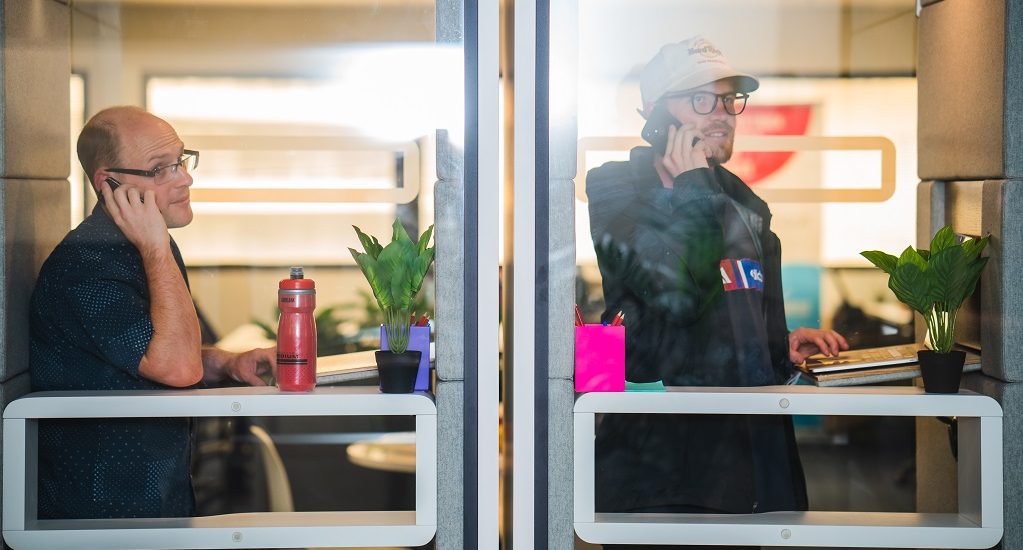- 6 May 2020
- Posted by: Canberra Innovation Network
- Categories: COVID-19, Coworking, General News

OPINION ARTICLE by Petr Adamek CEO, Canberra Innovation Network
The world has been volatile, uncertain, complex, and ambiguous (VUCA) even before COVID-19. However, our connected collective global and local restrictions to protect public health took the VUCA-world concept to an entirely new level. We are having to rapidly change many things we do, consume, enjoy or take for granted. But perhaps one of the most profound changes affecting most of the workforce around the world now, is the massive and instant introduction of the working-from-home (WFH) phenomenon.
And it is not just parts of the team working from home occasionally. This is entire companies, industries, and their value chains, including customers, suppliers, consultants, lawyers, universities and education systems, regulators, industry associations and many other stakeholders – broadcasting from their bedrooms, lounges and living rooms.
We can no longer talk about “just” a seismic shift – this is an earthquake in progress in terms of how rapid, massive and strongly felt this change is. A change that creates a mixture of feelings: anxiety and fear from the uncertainty and ambiguity colliding with the often ‘guilty’ excitement from the new and unimagined opportunities.
So, how important is it really, where we work from in the digital age? And how important will it be post-COVID-19? If you think about the coworking industry, it creates an offering that targets the office market exactly between the corporate office and home office. And this very thing could be its key strategic competitive edge in the new post-COVID-19 normal.
Foreshocks
There were an estimated 26 thousand co-working spaces around the world at the beginning of 2020 and they have been particularly popular with startups, SMEs and freelancers with growing interest from corporates who have been cautiously experimenting with the distributed office space model. Coworking spaces provide a sense of community, inspiration and a place where you can connect, learn, contribute and provide/receive help from like-minded fellow co-workers.
Coworking users appreciate the flexible terms, scalability, shared costs, shared technology and infrastructure that these spaces offer. They also enjoy the plug-and-play character of the offering where everything is ready to go, typically in a CBD (or fringe CBD) location where commercial rent prices and terms for operating individually leased space could be cost prohibitive. The community aspects and individual character of different spaces often reflect the personality and philosophy of the coworking space founders and managers. Social and learning events, unique spatial design and more importantly a unique blend of personalities of the other members add to the atmosphere and culture they co-create, contributing to a ‘home-like’ environment. These are often bottom-up cultures, shaped through contribution and co-ownership, rather than direction, contrasting the corporate atmosphere. Each coworking place has its unique energy and buzz that is defining and crucial for its existence.
Coworking itself has been going through three waves of development as industry insiders from OT/G point out. In the first wave, coworking emerged as a bottom up, community led, shared solution where business model was not a priority but community spirit was. In the second wave real estate business model focus took precedence over the community spirit and we saw many of the early spaces not being able to compete and closing down. In the third wave, the pendulum began to swing back towards a balanced approach in which business model sustainability was as important as the community and focus on interactions and productive linkages that users can build in the community. This is particularly important because ‘when it comes to innovation – community, culture and collaboration are the crucial pillars’ as Tracy Moyes and Jonah Merchant from O/TG emphasize.
Although there have been major hiccups (The WeCompany IPO), coworking has generally been growing in popularity and maturing rapidly (18,000 coworking spaces in 2018 compared to 26,000 in 2020). Enter COVID-19 and the WFH revolution, and many ponder the question: what is the future of coworking?
The Quake
In the short to medium term, the coworking business is hugely impacted. According to a March 2020 survey by The Co-worker who targeted 14 thousand coworking spaces around the world, 20% of respondents had to shut down and over one third experienced membership cancellations. And nothing suggests that these numbers are final. The longer the closures and restrictions, the higher rates of cancellations we will see. The irony of coworking in the current climate is that its core value proposition goes in the opposite direction to what everyone is doing right now. Many people are beginning to learn how to manage WFH successfully. Many businesses are learning how to leverage the new shape of the WFH productivity.
For some coworking operators, this may be the end of their journey. Even those who remain open during the restriction time will see a massive dip in the number of people on site. Larger tenants and those with more secure income – such as government projects – may continue to keep their tenancies and pay the membership fees out of solidarity but overall, the reduced demand in combination with relatively high costs of outgoings and new induced costs (such as increased need for cleaning and sanitation, maintaining low density, eliminating usage of event and meeting rooms, etc.), will make the model less profitable and lead to more coworking brands, large and small closing down permanently.
Different spaces, driven by different philosophies, respond differently. Hard line rent seeking organisations are charging in full even when their space is not accessible due to lock down. Those who are active in their communities are on the other side of the spectrum. I still remember quite vividly how immediately after the November 2016 earthquake in New Zealand, Wellington’s BizDojo became the sanctuary looking after their distressed members and providing support (shout out to exceptional community leaders such as Nick Shewring). This going together through a real quake and crisis and how the community is brought to support each other creates a lasting attachment to the brand and to the idea behind the organisation.
The Aftershocks
In April 2020, UK-based innovation research group NESTA anticipated ‘lasting interest in remote working models’ leading to a further ‘fall in commercial rents’. Corporate tenants will explore the optimal mix of corporate offices and other more flexible arrangements, including coworking memberships and working from home arrangements. Large office space users are rethinking their operating models, even as we write this post. The largest IT services firm in India, Tata Consultancy Services (TCS) switched 90% of their 450,000 workforce to the working from home model (called borderless office) overnight. And according to their CEO, ‘they are not coming back’. The new operating model, called 25/25, will see no more than 25% of TCS’s workforce working in offices at any given moment by 2025. And others will follow.
NESTA further anticipates decelerating suburbanisation: ‘normalisation of remote working might also slow the trend of people moving from countryside to cities, whilst prompting more interest in distributed organisations, and depressing commercial property rents.’ Office vacancies are already on the rise. In the United States, they are close to historic maximum of 10% vacant commercial space according to Financial Times, and the same trend applies to Australia (although as of April not yet reaching these levels) according to AFR.
For the coworking industry, this is not good news. Even prior to the ‘earthquake’, coworking was experiencing some turbulent development. While WeWork has contributed to the growth of coworking popularity and shown us investor readiness to risk-fund expansion of coworking, it’s fiasco has indicated that this is not a profitable way to grow a coworking business. The business model of coworking is one that can be simplified as a combination of a desk-as-a-service and community-as-a-service. For us, who manage coworking spaces, the latter is the cornerstone on which we will see the new (re-born) coworking industry being built.
The Re-birth
Here are my top predictions for the coworking industry over the next 5 years and my rationale behind these predictions. We will see a re-birth of coworking and its offering through the expansion of the range between the corporate office and bedroom office. Coworking will offer what neither of these end-of-spectrum models can; flexibility and variability will be the key. No more one-size-fits all.
 1. The preferred model.
1. The preferred model.
Even those who are perfectly comfortable to work from home, will want a variety of work spaces. It does matter where we work. People will be very keen to not work only from their home offices. Different spaces and different environments enable a different quality of individual and collective productivity. The transformation of corporate offices to coworking-like facilities with undedicated desks will continue, but it will not provide the same value as coworking. It is not cheap, corporations do not know how to do it well, it does not really reduce the need for commute, nor does it provide the benefits of tapping into diverse and different cultures. Corporations will embed the fabric of coworking spaces into their corporate resources and they will not really want to manage these locations themselves. It is not their core business. My prediction is that no corporation will be left untouched by the coworking model, and the shift will be faster and more significant than we can imagine now. SMEs will be even more important users because coworking will afford them more flexibility and scalability of their business models. Coworking will become the preferred and more mainstream method of using commercial space as we begin to recover from the recession. In fact, coupled with acceleration of the gig economy that also allows more flexibility to both providers and customers, it will help us recover from the recession faster.
2. More coworking spaces.
My prediction is that while in the short-term coworking spaces may be closing, the industry will recover – and it will be faster than mainstream commercial real estate. In fact, the cancellations and lower rates of renewal of longer-term CBD commercial leases will create a growth in demand for more flexible arrangements in a variety of locations in cities, regionally, nationally and internationally. A demand that no single coworking entity will be able to match with their growth model. This will be achieved by a related variety of dispersed coworking offerings that will keep popping up to meet this demand. We will see the number of coworking spaces double in the medium term.
3. More diversity.
Within any city as well as in suburban areas, we will see a huge variety of coworking offerings. While the basic parameters will be a given, the coworking spaces will compete with everything that is non-standard. Social events, partnerships with fitness clubs, city and regional coworking ‘passports’, facilitated mentor engagements or even support packs to enable users successfully blend coworking and working from home are just some of the perks we will see. The offerings will create an unimaginable office-work-experimentation network. It will be the opposite of one-size-fits-all commercial real estate. In addition, we will see re-emergence of the niche models. Imagine the least predictable combinations: Theatre/art gallery coworking, school/library coworking, sports grounds coworking, hospital coworking, charity coworking, hospitality coworking, cybersecurity/defence focused coworking, retail coworking, etc. Quirky collaborations, specialisation and niche character will attract its own clientele. The niche coworking communities will collaborate across locations to enable connectivity and progress of their particular models regionally and globally.
4. Shifts in size, design and technology.
The next wave of coworking will see a denser network of relatively smaller spaces; large coworking footprints will be less popular. Smaller coworking spaces will coexist with other uses of the building but not take up whole buildings. Part of the reason for this is the flow through character of coworking, along with manageability. However, more practically now, tracing infections and managing infection protocols is more complex and potentially poses higher risk on larger campuses. You will no longer see larger teams in the same location anyhow, as higher utilisation of WFH becomes the normal business strategy. A business using 3 to 4 coworking locations rather than one large office diversifies infection impact risk better. The tension between sustainability and manageability resulting in search for optimal size of coworking will continue. Regarding space design, we will see a shift towards more serviced office component of coworking. We will see even more work areas where you can have video calls individually, but they will not be separated from the shared areas. This is because the coworking offering cannot look like your home office – “alone in a (bed)room”. It has to include you socially even while physical distancing restrictions are active (what a great and challenging design task). New spaces will be also designed with infection control mindset – antibacterial surfaces and materials, enough space to allow effective distancing, ultraviolet treatment of air conditioning systems, wipeable privacy screens. There will be more technology to enable people tracing and more protocols including cleaning to enable proactive infection prevention. Workspace Operator Readiness Council is already collaborating on this. Smaller footprints will also accelerate more automation and experimentation with new management methods to enable better infection control (such as team A vs team B), drive productivity gains and enable experimentation with price (for analogy think Aldi vs Coles and Woolworths).
5. Almost perfect price discrimination.
The downward price pressures on commercial property will translate into coworking as well. Affordability may not be an issue for established corporate customers, but it will be for start-ups or operators in industries that are restructuring. We will see a diversification of pricing models through sponsored and cross-subsidised coworking, and in-kind contributions to community in return for reduced fees. The owners and managers of coworking will have to look at overall long term economic (and other types of) value when they manage their pricing models as opposed to simple scale pricing (again, no more one-price-fits-all).
6. Suburbanisation of coworking.
This will accelerate, leaving some downtowns to face another wave of decline caused by this ‘digital urban sprawl’. The CBD attraction power is being reduced by the current WFH outbreak – nobody misses long traffic jams and high parking prices. More people spending more time in the suburbs (and regionally) will see growth in service offerings and increased ‘life’ in these areas. Those new services will include coworking of different sorts. More cycling and walking to work. More community connections. More frequent alternations between working from home and from coworking locations. This is the chance for the reborn coworking.
7. Coworking as anchor tenant.
This is probably the most significant change I am predicting: coworking will come to the rescue of commercial property owners. Empty commercial property will be a big problem and will create a big incentive for innovation by commercial property investors. In many cases, the landlords will begin to operate coworking spaces themselves. They will have no other choice. The long-term lease concept with passive return will be challenged. In many cases, landlords will partner with coworking operators and subsidise the coworking function to bring life to the buildings and spinout future tenants. These partnerships will vary in forms and will range from revenue or profit sharing to coworking as a fee-for-service models. This is not the first time landlords innovated to create demand. This is how the very first business incubators emerged which can be also traced as the origins of business accelerators and coworking. The commercial property industry will change as well, the provision of a building-as-a-service will see an emulation of the coworking space-as-a-service experience on a larger scale. Most importantly, it will include more flexible terms.
8. Innovation culture as a service.
This whole shakeup and looming recession of unprecedented social and economic consequences will only accelerate our expectations on productivity. The inequalities created in this crisis and its aftermath, will require progressive nations to create more wealth more efficiently and to redistribute it better. And it will be much harder with the circumvented international trade and only slowly easing restrictions on movement of people and goods. My prediction is that the role that innovation, knowledge generation and purposeful knowledge exploitation by skilled and talented people will play a more critical role in our ‘new normal’. This crisis has the potential, to redefine capitalism. And of course, I am hopeful that it will be for the better. Innovation will be such an important part of the solution. From hospitality and tourism to space exploration, climate change improvements to equality and wellbeing, the importance of innovation as a skill and ‘a way of growing’ will skyrocket. Coworking will coexist with incubators, accelerators, collaborative and open innovation systems that will be shared by a number of players. It will play a vital role in creating a network of these systems, a fabric that can be used by innovative people to generate and re-build our new world building a new type of entrepreneurship.
We all know that innovation thrives in collaborative, serendipitous, experimental, diverse and “non-standard” environments that inspire and motivate people and expose them to different thinking styles and cultures. Environments that can be tapped into by corporates, governments, small businesses, startup entrepreneurs and social enterprises alike, environments rich and dynamic beyond what one corporate culture can create. Environments that in my opinion can be created by the rainforest of new redefined coworking spaces we are going to see as we recover from this crisis.

